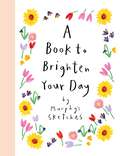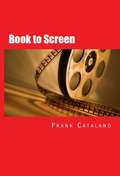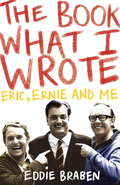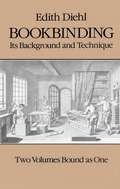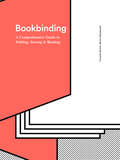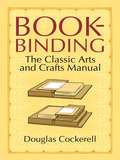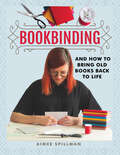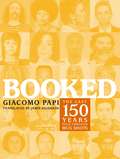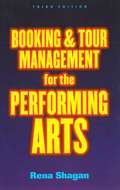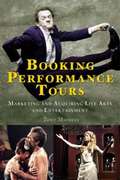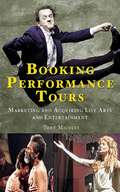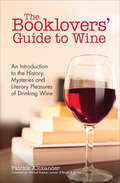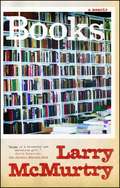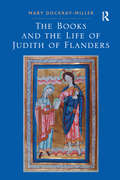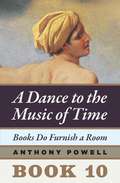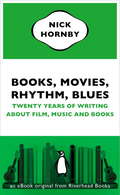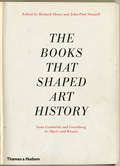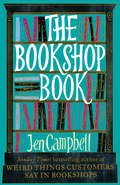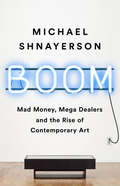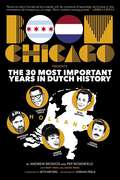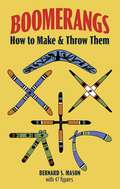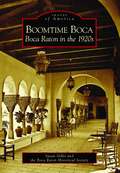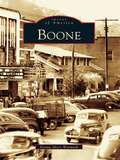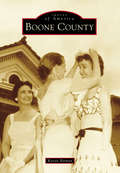- Table View
- List View
A Book to Brighten Your Day: Murphy's Sketches
by Kerri CunninghamThis is a heart-warming collection of illustrations from the much-loved viral sensation, Murphy's Sketches (@murphys_sketches) on Instagram. The perfect gem of a gift for yourself or for your loved ones - A Book to Brighten Your Day is a comforting treasury of positivity and joy. Filled with stunning drawings, life-affirming words and inspirational poems, these pages will make you pause, take a breath and appreciate the beauty in the smaller, everyday moments. It's the perfect guide as you reset at the beginning of the year, enjoy the world in bloom in spring, make the most of the summer sunshine and finally, get cosy and festive as the year ends. Featuring over two hundred beautiful, calming and entertaining illustrated pages, A Book to Brighten Your Day will help you find joy everyday, come rain or shine.
Book to Screen (How to Adapt Your Novel to a Screenplay #5)
by Frank CatalanoADAPTING YOUR NOVEL INTO A SCREENPLAY BOOK TO SCREEN was first presented as part of the 25th Annual Writer's Conference sponsored by San Diego State University on February 6 through the 8th, 2009 at the Double Tree Hilton Hotel in Mission Hills, California. The following transcript was presented and recorded by Frank Catalano as part of the programs offered at the conference. The book is based partly upon that presentation, focuses on the adaptation of an existing novel into a screenplay for presentation as a motion picture, television program or Internet content. Writers of fiction and non-fiction and industry professionals from the publishing business primarily attended the 25th Annual Writer's Conference. Mr. Catalano's seminars focused upon those writers seeking to adapt their novels into screenplays. The complete list of seminar presentations by Frank Catalano for this conference is: BOOK 1: WRITE GREAT CHARACTERS IN THE FIRST TEN PAGES BOOK 2: WRITING ON YOUR FEET - IMPROVISATIONAL TECHNIQUES FOR WRITERS - Part 1 BOOK 3: START YOUR STORY AT THE END BOOK 4: THE FIRST TEN PAGES BOOK 5: BOOK TO SCREEN BOOK 6: ACTING IT OUT - IMPROVISATIONAL TECHNIQUES FOR WRITERS - Part 2 BOOK 7: WRITE GREAT DIALOGUE
The Book What I Wrote: Eric, Ernie and Me
by Eddie BrabenThe hilarious memoir of Britain's best-loved, highly successful comedy writer Eddie Braben, whose scripts for Morecambe and Wise catapulted the incomparable duo to stardom. The key figure behind the success of Eric Morecambe and Ernie Wise, scriptwriter Eddie Braben has written his autobiography - with the inimitable, timeless humour, warmth and affection for Eric and Ernie of that wonderful bygone era which made their classic sketches so successful. From Liverpool to London and on to Snowdonia, Braben peppers his story with wonderful anecdotes about the original straight man and his amiable sidekick. The Book What I Wrote is as much a unique biography of the charismatic Eric and Ernie as it is an autobiography of the man on whose gags their success was made.
Bookbinding: Its Background and Technique
by Edith DiehlEdith Diehl (1876-1955) was one of the world's foremost practitioners of traditional bookbinding and an exceptionally able teacher. From the vantage point of a lifetime's experience, she gives today's bookbinders a historical survey of this centuries-old art and an eminently practical guide.Nearly one half of the encyclopedic volume is devoted to an overview of the historical development of bookbinding. The author shows how the codex form of the book became identified with the Christian era, how bookbinding became a craft and trade in the 15th century, and how the production and distribution of books shifted from the monasteries and universities to the illustrious printer-publishers of the 15th and 16th centuries. She describes various bookbinding practices such as sewing, the use of boards and leathers, hand versus machine binding, cased books, etc. And she examines in depth the different national styles of book decoration in Italy, France, England, Germany, North America, and other countries, and the specific contributions of such influential bookbinders as Jean Grolier, Thomas Mahieu, Le Gascon, Samuel Mearne, Roger Payne, Jacob Krause, Edmund Ranger, and John Ratcliff. Ninety-two full-page plates provide visualization of certain key points and, above all, numerous examples of the finest decorated bindings.Edith Diehl then guides the reader through more than 400 profusely illustrated pages on the craft of hand bookbinding. She details and illustrates the steps involved in the nearly 30 necessary binding operations: collating and paging, pulling and removing glue, guarding and mending, pressing, sewing, backing, lacing-in, headbanging, lining up back, casing texts in protective cover, covering, cutting inside margins and filling in, and many more. In addition she conveys much useful information on such ancillary topics as doublures, fly-leaves, half bindings, limp bindings, vellum bindings, slipcases, repairing old bindings, cleaning and washing papers, materials (leather, paper, gold leaf, glue, paste), finishing tools, tooling, lettering, etc. The 242 illustrations that accompany this book-within-a-book are unmatched for economy and clarity.
Bookbinding: A Comprehensive Guide To Folding, Sewing And Binding
by Franziska Morlok Miriam WaszelewskiThis comprehensive reference guide explores bookbinding techniques in start-to-finish detail, explaining all possible options in clear illustrations and easy-to-follow text, making it easy for artists and designers to compare and choose among them. From types of paper to folding methods, to all of the available paperback and hardcover bindings, to finishing techniques and case studies by contemporary designers, Bookbinding is truly the must-have book for professional designers and production staff. Bookbinding is also a work of art in its own right, given an award by the Type Director's Club for typographic excellence.
Bookbinding: The Classic Arts and Crafts Manual
by Noel Rooke Douglas CockerellOne of the principal texts of the Arts and Crafts movement in England, this classic work brought a resurgence of life and vigor to the ancient craft of binding books by hand. Its fame and usefulness has endured for more than a century, as evidenced by the many contemporary bookbinders and libraries who consider it to be the clearest and most valuable exposition of the technique of hand bookbinding in English.The text concisely covering virtually every aspect of the craft -- from folding and collating pages, trimming and gilding edges, and cutting and attaching boards to preparing covers, mitring corners, designing and inlaying on leather, pasting down end papers, and creating clasps and ties. More than 20 informative text diagrams and eight plates, as well as a glossary and an index complete this important manual.A "must-have" for craftspeople, libraries, and book preservationists, the volume remains one of the most valuable manuals available on the technique of hand binding.
Bookbinding and How to Bring Old Books Back to Life (Crafts Ser.)
by Aimee SpillmanRemedies the gap in the market for an easy to follow beginners book binding that's fun for the whole family!This book is a breath of fresh air showing you the fundamental skills and techniques you will need to start binding your own books. You don’t need a lot of expensive tools or materials to do bookbinding and this guide has been made to make the process accessible for any one who wants to do some “weekend projects”. This book will appeal to people who love books, but lead busy lives and yet still want to be creative. It will show you the basics and teach the fundamental skills and practices that will get you binding your own books in no time. These skills will then be transferable across a number of projects contained within and hopefully make you want to learn more. The ‘Weekend Projects’ will include how to do simple repairs on your old and well loved books, giving them a new lease of life, including adding hard covers to paperbacks and doing simple repairs. Along with these we will be creating bespoke notebooks and it will show you some unique ways to use your new found binding skills to keep and store your special cards. The aim of this book is to inspire new binders young to old and everything in between.
Booked: The Last 150 Years Told through Mug Shots
by Jamie Richards Giacomo PapiEvery year twelve million Americans are arrested and photographed by the police. In many ways, mug shots are our history. Using a dazzling selection of mug shots that are arrestingly raw in their starkness and strangely eloquent in their simplicity, this absorbing, humorous, often bewildering collection sheds a whole new light on our rebellious century.From political icons Martin Luther King Jr.and Angela Davis, to A-list celebrities Hugh Grant and 50 Cent, from killer Ted Kaczynski to the actor who aided in Abraham Lincoln's assassination, from prisoners of Auschwitz to a bearded Saddam Hussein, all of them declare a simple truth: The last 150 years told through police photography is truly an alternative history. Author Giacomo Papi's brisk and insightful commentary enlightens us with intriguing backstories and little-known facts.A feast for the eyes and the mind, Booked presents an ingenious and utterly unique snapshot of our times.
Booking and Tour Management for the Performing Arts
by Rena ShaganThis third edition of Booking and Tour Management for the Performing Arts has been updated to include information about the revolutionary new ways that performers, managers, and presenters are using the Internet to transform the business of booking live performing events. Special chapters by outside experts provide in-depth information about what presenters need from artists, the technical aspects of touring, the unique demands of touring abroad, and touring through the eyes of the artist. The book includes a Tour Manager's Resource Kit and numerous other ready-to-use sample materials, including a contract, letter of agreement, technical information questionnaire, performance checklists, calendars, schedules, tour budget model, technical glossary, and much more.
Booking Performance Tours
by Tony MicocciBooking Performance Tours is the quintessential guide for anyone involved in the touring of live arts and entertainment-as a producer, artist, presenter, agent, manager, or attorney. Industry insider Tony Micocci shares keen insights on: --Relationships among producers, agents, managers, and presenters --Negotiating styles --Taxation --Technology --Ethics in professional dealings --Booking strategies --Nonprofit versus commercial touring --Special considerations for booking Broadway and popular music --International touring --External factors affecting the field Booking Performance Tours includes nearly 100 pages of appendixes containing engagement contracts, technical riders, deal memos, and representation contracts, with extensive point-by-point analyses of all provisions. This book is destined to become the classic reference for the industry.
Booking Performance Tours: Marketing and Acquiring Live Arts and Entertainment
by Tony MicocciPack up the costumes and the instruments! It's time to take your show on the road. For anyone who manages, produces, represents, or works in a repertory theater, dance company, or next-hot-thing band, Booking Performance Tours presents all the information needed to book live shows. The process is complex--presenters, agents, lawyers, board members, investors, funders, transporters, freight companies, and artists are all involved--but this book makes it simple by breaking it all down into manageable pieces, explained in a straightforward, readable style. Full information on riders, negotiating, documents, taxes, tech, media, and many more essential details is included. Get this book, and hit the road!
The Booklovers' Guide to Wine: An Introduction to the History, Mysteries and Literary Pleasures of Drinking Wine
by Patrick Alexander Mitchell KaplanA delightfully informative guide to two of the world’s most rewarding pleasures—fine wine and great literature—that make for an irresistible pairing. Nothing in the world is more satisfying to the soul than a glass of excellent cabernet sauvignon, pinot grigio, bordeaux, or any number of fine varietals—unless it’s curling up by the fire with a truly exceptional novel, history, or collection of short fiction. Now Patrick Alexander, wine aficionado and author of The Illustrated Proust, combines these unparalleled pleasures in a unique guidebook to delight connoisseurs of both Gatsby and the grape. In The Booklovers’ Guide to Wine, Alexander shares his passion for the culture and history of wine and his love of great authors and their enduring works. Eschewing the traditional pairings of food and drink, he explores instead the most pleasing combinations of reds, whites, and rosés with their most compatible writers—be it Shakespeare with sherry, Jane Austin with chardonnay, or J.R.R. Tolkien with albariño. In addition, he examines the most interesting and thought-provoking wine references in literature while providing an intriguing history of the beloved beverage from biblical times to the latest trends. Chock-full of intriguing facts, expert opinions, and entertaining anecdotes, The Booklovers’ Guide to Wine is a book to be savored by anyone who appreciates the complexity of a full-bodied shiraz or the unmistakable flavor of a great author.
Books: A Memoir
by Larry McmurtryMcMurtry, who wrote the Oscar-winning screenplay for "Brokeback Mountain," returns with a fascinating and surprisingly intimate memoir of his lifelong passion of buying, selling, and collecting rare and antiquarian books.
The Books and the Life of Judith of Flanders
by Mary Dockray-MillerIn the first full-length study of Judith of Flanders (c. 1032-1094), Mary Dockray-Miller provides a narrative of Judith’s life through analysis of the books and art objects she commissioned and collected. Organizing her book chronologically by Judith’s marriages and commissions, Dockray-Miller argues that Judith consciously and successfully deployed patronage to support her political and marital maneuverings in the eleventh-century European political theater. During her marriage to Tostig Godwinson, Earl of Northumbria, she commissioned at least four Gospel books for herself in addition to the numerous art objects that she gave to English churches as part of her devotional practices. The multiple treasures Judith donated to Weingarten Abbey while she was married to Welf of Bavaria culminated in the posthumous gift of the relic of the Holy Blood, still celebrated as the Abbey’s most important holding. Lavishly illustrated with never before published full-color reproductions from Monte Cassino MS 437 and Fulda Landesbibliothek MS Aa.21, The Books and the Life of Judith of Flanders features English translations of relevant excerpts from the Vita Oswinii and De Translatione Sanguinis Christi. Dockray-Miller’s book is a fascinating account of this intriguing woman who successfully negotiated the pitfalls of being on the losing side of both the Norman Conquest and the Investiture Controversy.
Books Do Furnish a Room: Book Ten of A Dance to the Music of Time
by Anthony PowellAnthony Powell's universally acclaimed epic A Dance to the Music of Time offers a matchless panorama of twentieth-century London. Now, for the first time in decades, readers in the United States can read the books of Dance as they were originally published-as twelve individual novels-but with a twenty-first-century twist: they're available only as e-books. The tenth volume, Books Do Furnish a Room (1971), finds Nick Jenkins and his circle beginning to re-establish their lives and careers in the wake of the war. Nick dives into work on a study of Robert Burton.
Books, Movies, Rhythm, Blues
by Nick HornbyA new collection of nonfiction writing on culture from the bestselling author of High Fidelity. Books, Movies, Rhythm, Blues brings together the best of Nick Hornby's non-fiction pieces on film and tv, writers and painters and music, and including one exceptional fragment of autobiography. With subject matter ranging from the Sundance Festival to Abbey Road Studios, from P.G. Wodehouse to The West Wing, these are pieces that 'were written for fun, or because I felt I had things to say and time to say them, or because the commissions were unusual and imaginative, or because ... I was being asked to go somewhere I had never been before.'
The Books that Shaped Art History: From Gombrich and Greenberg to Alpers and Krauss
by Richard Shone John-Paul StonardAn exemplary survey that reassesses the impact of the most important books to have shaped art history through the twentieth century Written by some of today's leading art historians and curators, this new collection provides an invaluable road map of the field by comparing and reexamining canonical works of art history. From Émile Mâle's magisterial study of thirteenth-century French art, first published in 1898, to Hans Belting's provocative Likeness and Presence: A History of the Image before the Era of Art, the book provides a concise and insightful overview of the history of art, told through its most enduring literature. Each of the essays looks at the impact of a single major book of art history, mapping the intellectual development of the writer under review, setting out the premises and argument of the book, considering its position within the broader field of art history, and analyzing its significance in the context of both its initial reception and its afterlife. An introduction by John-Paul Stonard explores how art history has been forged by outstanding contributions to scholarship, and by the dialogues and ruptures between them.
The Bookshop Book
by Jen CampbellWe're not talking about rooms that are just full of books. We're talking about bookshops in barns, disused factories, converted churches and underground car parks. Bookshops on boats, on buses, and in old run-down train stations. Fold-out bookshops, undercover bookshops, this-is-the-best-place-I've-ever-been-to-bookshops. Meet Sarah and her Book Barge sailing across the sea to France; meet Sebastien, in Mongolia, who sells books to herders of the Altai mountains; meet the bookshop in Canada that's invented the world's first antiquarian book vending machine. And that's just the beginning. From the oldest bookshop in the world, to the smallest you could imagine, The Bookshop Book examines the history of books, talks to authors about their favourite places, and looks at over three hundred weirdly wonderful bookshops across six continents (sadly, we've yet to build a bookshop down in the South Pole). The Bookshop Book is a love letter to bookshops all around the world. --"A good bookshop is not just about selling books from shelves, but reaching out into the world and making a difference." David Almond (The Bookshop Book includes interviews and quotes from David Almond, Ian Rankin, Tracy Chevalier, Audrey Niffenegger, Jacqueline Wilson, Jeanette Winterson and many, many others.)
Boom: Mad Money, Mega Dealers, and the Rise of Contemporary Art
by Michael ShnayersonThe meteoric rise of the largest unregulated financial market in the world-for contemporary art-is driven by a few passionate, guileful, and very hard-nosed dealers. They can make and break careers and fortunes. <P><P>The contemporary art market is an international juggernaut, throwing off multimillion-dollar deals as wealthy buyers move from fair to fair, auction to auction, party to glittering party. <P><P> But none of it would happen without the dealers-the tastemakers who back emerging artists and steer them to success, often to see them picked off by a rival. Dealers operate within a private world of handshake agreements, negotiating for the highest commissions. <P><P>Michael Shnayerson, a longtime contributing editor to Vanity Fair, writes the first ever definitive history of their activities. He has spoken to all of today's so-called mega dealers-Larry Gagosian, David Zwirner, Arne and Marc Glimcher, and Iwan Wirth-along with dozens of other dealers-from Irving Blum to Gavin Brown-who worked with the greatest artists of their times: Jackson Pollock, Andy Warhol, Cy Twombly, and more. <P><P>This kaleidoscopic history begins in the mid-1940s in genteel poverty with a scattering of galleries in midtown Manhattan, takes us through the ramshackle 1950s studios of Coenties Slip, the hipster locations in SoHo and Chelsea, London's Bond Street, and across the terraces of Art Basel until today. <P><P>Now, dealers and auctioneers are seeking the first billion-dollar painting. It hasn't happened yet, but they are confident they can push the price there soon.
Boom Chicago Presents the 30 Most Important Years in Dutch History
by Andrew Moskos Pep RosenfeldAn exciting history of the improv group you've never heard of that changed comedy in America—this is the story of Boom Chicago in Amsterdam as told by its founders and most famous alumni. "It’s kind of crazy, the impact on culture so many Boom Chicago alums have had. Boom was where I became my best comedic self: the excitement of Amsterdam, the freedom of that environment, the letting loose—it's magic. There's no better training ground." —Jordan Peele "Boom Chicago should have ended up on the scrap heap of 'Terrible Ideas Americans Have While Stoned in Amsterdam.' But when you stubbornly love one thing (comedy) as much as another thing (Amsterdam), you just believe they should be together. And here we are—thirty years later, Boom Chicago is alive and kicking." —Seth Meyers "Working at Boom Chicago was an unbelievable experience. Thank goodness someone was smart enough to write it all down! You're lucky 'cause you get to read about THE most exciting, fun, and illegal time I've ever had!" —Amber Ruffin Featuring interviews with: Meyers, Peele, Ruffin, Jason Sudeikis, Ike Barinholtz, Greg Shapiro, Kay Cannon, and many more; and a sixteen-page, full-color insert with both behind-the-scenes snapshots and images from live performances. What do Ted Lasso, Get Out, Late Night with Seth Meyers, 30 Rock, A Black Lady Sketch Show, Breaking Bad, Saturday Night Live, Girls5Eva, The Colbert Report, Inside Amy Schumer, Pitch Perfect, Key & Peele, The Daily Show, MADtv, Rick and Morty, The Amber Ruffin Show, Horrible Bosses, Portlandia, It's Always Sunny in Philadelphia, Suicide Squad, Superstore, How I Met Your Mother, Wicked, The Pee-Wee Herman Show, Brooklyn Nine-Nine, and Broad City all have in common? They all feature writers, creators, directors, or stars who got their start at Boom Chicago. Having risen roughly to the middle of Chicago's cutthroat comedy scene, Andrew Moskos and Pep Rosenfeld decamped the Midwest for Amsterdam, Netherlands in 1993 to start their own improv comedy troupe, Boom Chicago. In a foreign land with zero tradition of English-language humor, Moskos and Rosenfeld unwittingly created the finishing school for some of today's most groundbreaking comedic talents. They (along with coauthors Matt Diehl and Saskia Maas) document this journey in the definitive oral history Boom Chicago Presents the 30 Most Important Years in Dutch History. From its stages, Boom Chicago went on to launch cultural game changers like Seth Meyers, Jordan Peele, Amber Ruffin, Jason Sudeikis, Brendan Hunt, Ike Barinholtz, Kay Cannon, and Tami Sagher (and that's just a partial list). At Boom, these young upstarts honed their craft in front of unsuspecting foreign audiences and visiting dignitaries like Burt Reynolds, Run-DMC's Jam Master Jay, Dutch royalty, and the Netherlands's prime minister—all while navigating a world with legal weed and prostitution, annual holiday celebrations involving blackface, cookies with weird racist names, and football that has nothing to do with the NFL. From this culture shock, this collective created a more topical, inclusive, tech-savvy humor that would become the dominant comedy style of our time. Praise for Boom Chicago: "The Groundlings. The Harvard Lampoon. Second City. These comedy institutions have been supplying Hollywood with a steady stream of talent for decades. Well, there's another name—almost as influential—that you've never heard of: Amsterdam's Boom Chicago. Huh?"—G.Q. "A small theater in Amsterdam became the most influential American comedy factory you've never heard of . . . Boom alums have had a significant hand in many of the shows that defined the past two decades of comedy." —New Yor
Boomerangs: How to Make and Throw Them
by Bernard S. MasonIt only takes minutes to make a good, guaranteed-to-return boomerang. By following a few more simple steps you will learn how to throw it so it will always return to you. Soon you will be in possession of a new hobby, experimenting with many types of boomerangs, flying them in new tricks and stunts, achieving a degree of accuracy and excitement that will give you pleasure whether you are young or old, whether it is your first boomerang or your fiftieth.This is the outstanding book on boomerangs. While a certain amount of the information is drawn from native methods, most is composed of new designs by Bernard Mason that are easy to make, easy to throw, safe, and full of possibilities. There are the standards — cross-stick boomerangs ranging in size from fourteen inches to three feet. There are pin-wheel boomerangs, undoubtedly the best flyers. There are boomabirds, boomerangs in bird shapes, airplane shapes, and other ornamentals with a wealth of strange flight patterns. There are tumblesticks, boomerangs that look like nothing but simple straight sticks — until you throw them. There are boomerangs you can make from cardboard. And there are the curved stick boomerangs from Australia. In each section there are examples of the best flyers, plus others — largest, smallest, jumpers, fast flyers, smooth flyers, and many more.Since, as the author says, each boomerang possesses its own unique character, there is always the feeling of magic each time a new one is made and thrown. With this book you can learn to make nearly every type of known boomerang, learn to fly them, and add a new area of skill and recreation to your life.
Boomtime Boca: Boca Raton in the 1920s (Images of America)
by Susan Gillis Boca Raton Historical SocietyBoca Raton, Florida, was a tiny farming community onthe southeastern coast of Florida when the state's 1920s real estate boom grew into a national phenomenon. Investors and new residents were drawn to the state from all over the country, a time Floridians referred to as "the Boom." In April 1925, well-known Palm Beach society architect Addison Mizner revealed his plans for an ambitious newdevelopment in Boca Raton. The plans included a gigantic oceanfront hotel, elegant mansions, golf and polo grounds, and palm-lined boulevards. The popularity of Mizner's projects stimulated many similar developments within the region, increasing the population of the town from 100 to several hundred residents. By the fall of 1926, however, theFlorida land boom came to an end. Boca Raton returned, for the most part, to its small-town agricultural heritage by 1930. By the end of the 20th century, boomtime dreams were fully realized and Boca Raton became one of Florida's most prestigious addresses.
Boone
by Donna Akers WarmuthIt was the Old Buffalo Trail that led both Native Americans and Daniel Boone to the site of present-day Boone, North Carolina, at an elevation of 3,333 feet. Located among the scenic and cool mountains of the High Country, Boone was for a long time a seasonal hunting spot with only a few settled families. After the Civil War the community's population began growing, and in 1899, the tiny town of Boone included 150 residents. In the 1880s, the treacherous and steep Boone and Blowing Rock Turnpike began to bring commerce and visitors to the mountains. Although this remote town was an unlikely location for a school, Watauga Academy was established in 1899, and it would later become Appalachian State University, one of the top-ranked Southern public colleges.
Boone County (Images of America)
by Kassie RitmanBoone County, founded on April Fools' Day in 1830, is situated in the center of the state, abutting Indiana's capital, Indianapolis. The first settlers found swampy land overgrown with ancient hardwoods, riddled with rattlesnakes, and teeming with wetland creatures--most famously, frogs. Although life was challenging for the area's first settlers, most persevered. Many chided that Boone was not fit to be included as a part of the fledgling state of Indiana. They dubbed the newly platted area as the "State of Boone" to set it aside from the superior farmland and living conditions found elsewhere in Indiana. Boone County's first census counted 621 persons in 1830. Today, many of the original surnames remain prevalent among a population that exceeds 60,000 residents.
